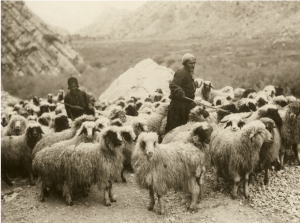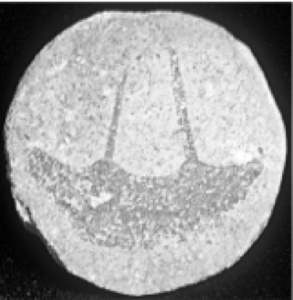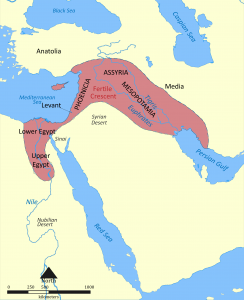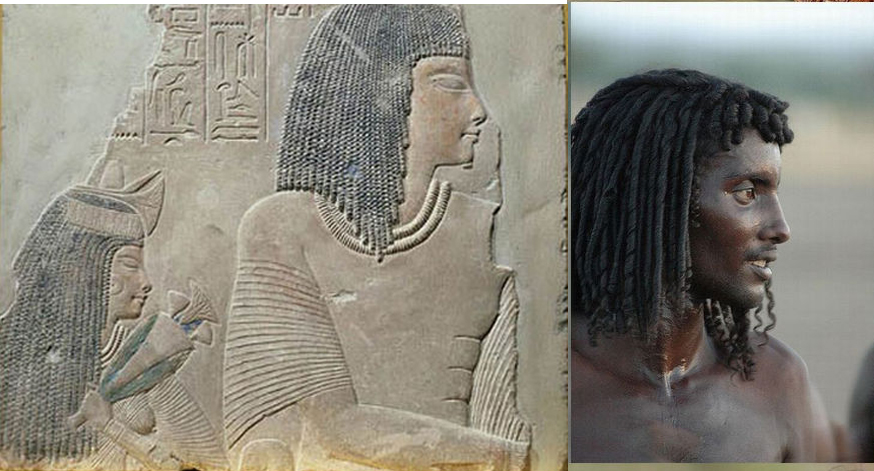Spread of the Levantine Pastoralist
Work at the site of ‘Ain Ghazal in Jordan has indicated a later Pre-Pottery Neolithic C period, which existed between 8,200 and 7,900 YPB, which is congruent with the split of E-V22 from fatherclade E-Z1919.
Juris Zarins has proposed that a Circum Arabian Nomadic Pastoral Complex developed in the period from the climatic crisis of 8200 YPB, partly as a result of an increasing emphasis in PPNB cultures upon animal domesticates, and a fusion with Harifian hunter gatherers in Southern Palestine, with affiliate connections with the cultures of Fayyum and the Eastern Desert of Egypt. Cultures practicing this lifestyle spread down the Red Sea shoreline and moved east from Syria into southern Iraq. (wiki)
Into Egypt
‘Herding appears ca. 7000 YBP, at a time of increased and possibly less seasonal rainfall, on large lateBashendi Asites with stone-built structures and a still-diversified food economy. With the drying trend after 6500 YBP , mobile Bashendi Bcattle and goat herders continue to aggregate in the oasis for a millennium, still utilizing a variety of resources.’ according to Mary M.A. McDonald in Early African Pastoralism: View from Dakhleh Oasis (South Central Egypt) (1998)
‘In the Nile Valley, the Saharian met and mixed with the descendants of the South Western Asian Neolithic population responsible for the introduction of the Southwest Asian agricultural tradition into the Nile Valley….’ Peter Bellwood (2005).
Allison Smith (2013): ‘The prime Northeast African haplogroup E candidate related to the arrival of farmers and/or pastoralists from the Levant is undated E-M34. E-V12(xV32) and E-V22 may well represent local adaptation.’
Into Mesopotamia
Again Juris Zarins in Early Pastoral Nomadism and the Settlement of Lower Mesopotamia (1990) : ‘The Akkadians’ nomadic origins have generally been assumed. However, the conventional prehistoric archaeological picture fails to illuminate those origins and the Akkadians’ involvement in Akkad.
Thus the origins of pastoral nomadism must be sought in the context of mixed farming within the Fertile Crescent, specifically during the PPNB. Subsequent expansion into marginal agricultural lands led to a symbiotic relationship between pastoral nomads and farmers. The Akkadians seem to have moved into the northern Arabian steppe and desert (Jezireh and Hamada) during the mid-seventh millennium B. C.; the PPNB/C populations apparently began intensive herding at the end of that period, and maintained ties to the Fertile Crescent seen in both exotic trade and everyday culture.
They began to penetrate into Akkad during the time under discussion. Archaeological sequences in the Arabian desert suggest that the Akkadians probably were of a West Semitic (Levantine) background. Thus, the alluvium in the Akkadian area became a distinct entity as early as ca. 8000 YBP and represented the early prehistoric forerunners to Akkadians of the fourth and third millennia B. C.’
The Neolithic of the Levant was close linked tot he Ubaid culture in Mesopotamia. M. Redha Bhacker and Bernadette Bhacker: “Oman’s early settlers were Neolithic pastoralists and seafaring people who worked trade routes from Mesopotamia to the Indus Valley. Arrowheads found in Qatar in 1960 by Danish prehistorian Holgar Kapel and ash from ancient campfires found in Muscat in 1983 are the earliest evidence of the nomads who followed their flocks south from the Levant, settling the Arabian peninsula 8,000 years ago. Remains of Neolithic camps found during the past three decades suggest that as Arabia’s climate became wetter, these herders thrived, roaming in widely dispersed groups from Syria and Iraq in the north to Dhofar in southern Oman.”
Alicia M Cadenas (2008): “Recent archaeological finds supports a trading relationship between Mesopotamia and the Arabian Gulf region dating back to the Al Ubaid Period (~7000 ybp) as evidenced by the excavation of Ubai pottery from Mesopotamia in UAE. Ancient maritime trade routes linking Mesopotamia to the Indus Valley included Dilmun (the island of Bahrain) and Magan (in the southeastern tip of the Arabian Peninsula). It is possible hat the close ties between Mesopotamia with both the Nile River Valley and the ancient Persian Gulf region during the Neolithic helped disseminate these haplogroups.” In casu: E-V22.
Image: fertile crescent
Into the Horn of Africa
The E-V22 spread had his highest impact in the Horn of Africa. Due to the so called Savannah Pastoral Neolithic (5200-3300 ybp) E-V22 spread from Nubia/Kush to the Horn of Africa. In the most Eastern part of the Horn of Africa among the “Cushites” and closer to the outmost upper Nile Valley among the “Nilotic”. Tribes with the highest E-V22 are Saho, Eritrea (88%), Turkana Kenya (33%) Fulani, Sudan (30%), Beja, Eritrea (30%),Gurage, Ethiopia (29%), Masaai, Sudan, (16%).
The nowadays Saho men of Eritrea have 88% E-V22. They are not only a representative of a major founder effect of in the end Levantine pastoralist their name means literally pastoralist. “The word “Saho” means “nomad,” (“saa” means animals and “hoo” means caretaker), which is also an expression of their previous pastoral way of life. ” So E-V22 is probably rooted along “6000 BC to form what Juris Zarins calls the Syro-Arabian pastoral technocomplex, which saw the spread of the first Nomadic pastoralists in the Ancient Near East.” a torch still carried by the Saho.





